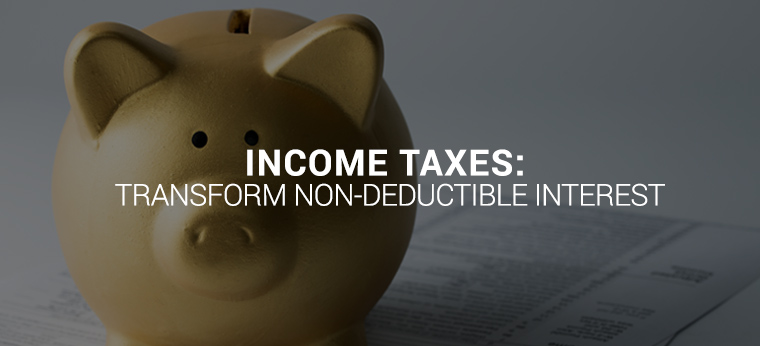
A lot of personal debt that consumers are paying for is considered non-deductible. Many are paying interest on credit cards, car payments, etc. The interest that is still considered a deductible is your home mortgage interest, and investment interest.
Each year, if you are paying substantial interest you may want to consider converting your non-deductible interest into interest that is deductible. So how can you transform non-deductible interest and save on income taxes.
Taking out a home equity loan
- One of the most ideal ways to do this is to pay off your consumer debt with a home equity line of credit. In general, individual taxpayers may borrow up to $100,000 of home equity where the interest can be deductible as home mortgage interest;
- When you use a home equity line to procure items such as a car or recreational vehicle, your interest can be deductible.
Things to consider before proceeding with this option : “Taking out a home equity loan”
- You must treat a home equity loan like a personal loan. It is important to pay it back in the same manner you would pay back your consumer loan. No one wants to retire without having his or her home paid for;
- Be sure when buying a vehicle that the interest or rebates you may get are a better offer than the interest you would get deducted on a home equity loan;
- The repercussions of defaulting on a home loan are much more grave than defaulting on a personal loan. Be sure you are able to pay it back.
Cash Damming
- Cash damming is essentially a technique where self-employed individuals, over time, convert their non-deductible debt into debt where the interest is deductible;
- Interest becomes tax deductible when personal debts are gradually converted into business debts;
- Useful for individuals who earn higher taxable incomes, have significant personal debt, have business or rental expenses;
- Good for individuals who own rental property;
- Requires opening 2 separate business accounts at your financial institution in order to separate your gross income from your business expenses;
- The first account is for your business or rental income;
- The second account is for your line of credit to be used for operating or rental expenses.
Things to consider before proceeding with this option : “Cash Damming”
- You must first meet with your financial planner to decide if you are eligible and if it is the right move for your business;
- If your business or rental property is ever used for personal purposes, you must exclude the personal portion of the payment from your line of credit;
- In order to choose this option, you must have a significant amount of guarantee for the line of credit. In other words, once the mortgage has been completely paid off, your personal residence may be used to guarantee the line of credit.
Everyone would prefer to benefit from deductible interest rather than having to pay for non-deductible interest. Many with school-aged children opt to pay for major purchases with credit cards or personal loans, which will most probably lead to significant non-deductible interest.
Owning your own home helps get you options which can allow you to transfer these non-deductible interest charges into deductible interest with a home equity loan. If there is a way for you to save money, why not opt for it? Meet with your financial planner to see which option is the best for you.

So many good posts i read here, i think you can make captaincash.ca go
viral easily using one tricky method. Just type
in google:
Ildis’s Method To Go Viral
you guys to our blogroll.|
The following are the benefits that you have to be
aware of the most. A lot of people have small business ideas
that they often fail to put into practice either because they lack the money to make an investment or because the
fear to lose everything. Always choose a new account, and look for a specialized bank whenever possible.
Its like you read my mind! You appear to know a lot about this, like you wrote the book in it or something. I think that you can do with some pics to drive the message home a little bit, but instead of that, this is excellent blog. An excellent read. I will certainly be back.